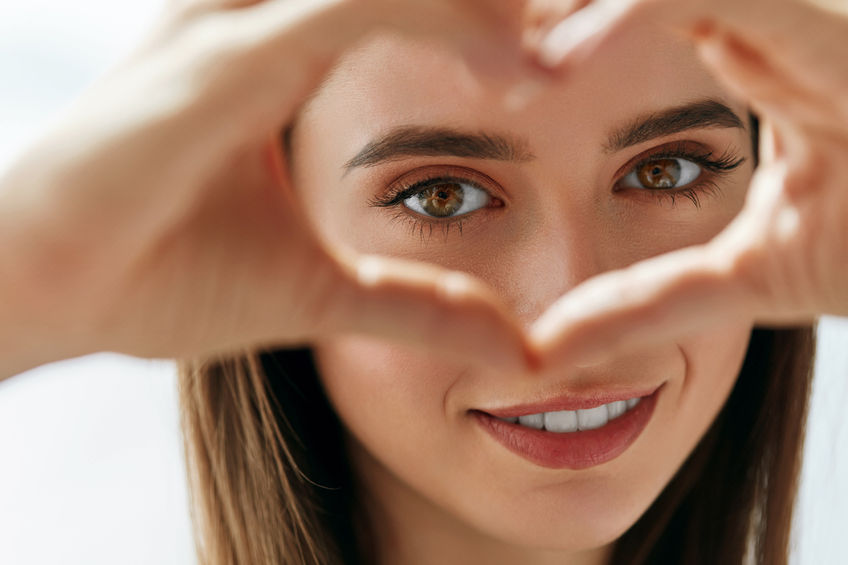The Healthy Eye from the Perspective of Maharishi Ayurveda - Part 1
Autumnal Moments - Part 1
Our eyes are the sensory organ that receives 70 to 80% of all our perceptions. It is therefore no wonder that our sense of sight is extremely important in conventional medicine (5 of the 12 cranial nerves are needed for the eyes alone) as well as in Ayurveda. This is also reflected in the classification of the doshas or subdoshas. There, each of the three doshas Vata, Pitta and Kapha is divided into five subdoshas. While normally each subdosha is responsible for several functions in the body, we find in the pitta dosha a separate subdosha (alochaka-pitta), which is exclusively assigned to the eyes. At the same time, there are other subdoshas that additionally influence the function of the eyes.
 Light and dark, depth of field and the play of colours in our world are sent through our eyes to the brain for processing. Disturbances in the state of health or even diseases of the eyes lead to a change in our perception. For this reason, it is important to maintain or restore the harmonious interplay of the three doshas. Ayurveda describes very precisely the processes of the overall quantum physical concept according to which disorders of the eye typically manifest. The importance of the so-called "third eye" also plays a prominent role here. Doshas disturbances at the eye Disturbance patterns in the body usually begin with an imbalance of the Vata-Doshas, continue via Pitta disturbances and finally manifest themselves in a Kapha change. The treatment concepts are to be aligned accordingly. Changes in kapha dosha, i.e. structural changes, are naturally more difficult to influence than pure vata disturbances.
Light and dark, depth of field and the play of colours in our world are sent through our eyes to the brain for processing. Disturbances in the state of health or even diseases of the eyes lead to a change in our perception. For this reason, it is important to maintain or restore the harmonious interplay of the three doshas. Ayurveda describes very precisely the processes of the overall quantum physical concept according to which disorders of the eye typically manifest. The importance of the so-called "third eye" also plays a prominent role here. Doshas disturbances at the eye Disturbance patterns in the body usually begin with an imbalance of the Vata-Doshas, continue via Pitta disturbances and finally manifest themselves in a Kapha change. The treatment concepts are to be aligned accordingly. Changes in kapha dosha, i.e. structural changes, are naturally more difficult to influence than pure vata disturbances.
- Vata disorders manifest themselves in the eye e.g. through:
- Rough feeling, sicca complaints (dryness)
- Scratching, stinging
- Corneal opacities
- Pale conjunctiva
- Cataract development (reduced transparency of the lens)
- Opacification of the vitreous humor
- Fragile vessels
- Strabismus (squint)
- Sicca syndrome
- Pitta disorders are characterised by, for example:
- Inflammation, "red eye
- Episcleritis, scleritis (inflammation of the sclera)
- Iritis, iridocyclitis, cyclitis (inflammation of the iris)
- Myositis (inflammation of the muscle layer in the eye)
- Hemorrhages in conjunctiva, sclera, retina etc.
- Kapha disorders manifest themselves in, for example:
- Deficient or excessive production of tear fluid
- Structural defects, macular degeneration, tumours
- Oedema, heavy eyelids (water retention)
- Cataract and glaucoma (cataract and glaucoma)
- Scleromalacia
Mirror of the soul
Anyone who has ever looked into the glazed eyes of a feverish child or into the shining eyes of a happy person knows: the eyes tell us a lot about a person and their well-being. Therefore, it is important to also look at the circumstances of a person with vision problems. Does the person perhaps simply no longer want to see certain things? Is a restriction of the visual field for no apparent reason caused by a concentration on the "inner vision"? There are even patients who, after a successful cataract operation and regained vision of 100%, were very sad because they had lost their "inner sight". Freely after Saint-Exupèry: "One sees well only with the heart, the essential is invisible to the eyes." Not everything that is technically possible is also the best therapy for every person.
The eye in contemporary medicine
Conventional medicine uses the view into the eye to gain clues to diseases - even those that go far beyond the eyes. Internal and neurological questions can be answered by looking into the eye. Nephrologists and diabetologists are grateful for an analysis of the vascular situation in the eye. The preparation of a stroke prognosis on the eye is almost routine. Often the ophthalmologist finds indications of a cerebral mass (brain tumour) in visual field and optic changes or disorders of pupil mobility before the neurologist. Gynaecologists want to clarify an impending eclampsia (pregnancy poisoning). Not to forget the numerous syndromes in which the eyes are also affected. The textbooks on ophthalmology in orthodox medicine are numerous. It is fascinating how finely traditional Ayurvedic writings distinguished disorders of the eyes as early as 3,500 years ago - and without the technical equipment that ophthalmologists have today. The Sushruta Samhita alone distinguishes 64, the Vaghbata Samhita even 94 different eye diseases.
Therapeutic possibilities of eye diseases in the Ayurvedic context
Therapeutic concepts of some eye diseases, especially the changes in the ageing eye, are fraught with difficulties in conventional medicine. Essentially, treatment in conventional medicine is based on the well-known concepts:
- Eye drops, gels, ointments (cortisone, antibiotics, mydriatics, antiglaucomatosa, etc.).
- Systemic administration of antibiotics/cortisone
- Cooling, rest, avoidance of stress (inability to work, ability to drive)
- Surgical therapy incl. laser treatments, intraocular injections
- High altitude cures
- Prosthetic treatment
In Ayurveda, not only the eye but the whole organism can be influenced by special procedures. There is a comprehensive system for therapy, which is individually adapted in each special case according to pulse diagnostics, tongue diagnostics and the condition of the patient. This includes for example:
- Behavioural and nutritional therapy
- Herbal preparations and rasayanas
- Marma point massages
- Purification therapies (Pancha Karma)
- Yoga and special breathing techniques (Pranayama)
- Sound therapy, Gandharva Veda
- Meditation techniques (e.g. Transcendental Meditation)
Even in the ancient Vedas, attention was paid to keeping the eyes healthy. The recommendation especially in summer is:
- Avoid excessive sunbathing
- Avoiding physical overload
- No rapid temperature changes from hot to cold (jumping into cold water after sweating)
- Splashing your eyes with cool water several times in the morning
- Drinking rose water to cool down
- Do not stare at objects for long periods of time (computers, mobile phones!)
- Do not sleep during the day, avoid sleep disturbances at night
Ayurvedic therapies especially for the eyes according to the Shalakya Tantra or Netra Chikitsa include e.g:
- Anjana (Ayurvedic kajal), which is still used in Egypt today
- Shirobasti (head oil treatment)
- Nasya (nasal reflex oil treatment)
- Shodhana (intestinal cleansing)
- Pancha karma
- Kashayadhara (eye wash with various herbal decoctions, honey)
- Shashtika sweda (warm poultices)
- Pichu (linen bag treatment)
- Netra tarpana (eye treatment with medicated oils or ghee)
- Extraction of thimira (cataract)
These treatments are extremely effective and can be used in parallel with conventional medicine as well as alone as an alternative therapy. A large part of these treatments are carried out in the Maharishi Ayurveda Health Centre Ried (Pancha Karma) In my practice I always start with the simplest method of detoxifying the body, the hot water drinking cure. This involves boiling water for 10 minutes and pouring it through a coffee filter into a thermos flask. You should drink 3-4 sips of this every half hour. This alone brings demonstrable improvements to the organism's general condition. The second step is to explain why a special daily routine is important for the healing process. The next step leads to nutritional knowledge, the use of certain spice mixtures that can be added to the food and the individual food preparation for the respective dosha constellation. This is to help improve the function of the 13 agnis, the digestive fires.
- Vata, Pitta, Kapha Churna and Tea
- Ginger tea
- Lassi
- Curcuma
- Avoid animal protein in the evening
- Few nightshade vegetables (potatoes, tomatoes, aubergines, etc.)
- Ama cure (special rice/mungdhal diet with spices)
- Eating in peace and with pleasure
It is important to get as much ojas as possible from the food and avoid ama. Ojas is the subtle essence that can be extracted from food and is used to build healthy body tissues. Ama (= the undigested), on the other hand, are waste products that cannot be processed as toxins in the body and are deposited uncontrollably.
Contact address Dr. med. Stephania Lorenz Specialist in ophthalmology Hans-Mielich-Str. 17a 85053 Ingolstadt Tel. +49 841 - 940096
Literature Lele, Avinash, David Frawley and Subash Ranade, "Ayurveda and Marma Therapy", Airlift Book Company (paperback 2003) Schmut, O. "Ghee, the gold of Ayurveda medicine - a clinical study on dry eye therapy", Power Point presentation of the University of Graz (personal reference) Schrott, Ernst "Die heilenden Klänge des Ayurveda", Karl F. Haug Fachbuchverlag, 2001 Schrott, Ernst and Cynthia Nina Bolen, "The Delicious Cuisine of Ayurveda: Eating with Body and Soul", (paperback, 2004)
Schrott, Ernst and Wolfgang Schachinger "Ayurveda - Fundamentals and Applications", Karl Trias Verlag, 2005 Schrott, Ernst and H.P.T. Ammon "Medicinal Plants of Ayurvedic and Western Medicine", Springer Verlag Berlin Heidelberg New York 2012 Schrott, Ernst, J.Ramanuja Raju, Stefan Schrott "Marmatherapy" Goldmann Verlag Munich, 2009


We look forward to your feedback!